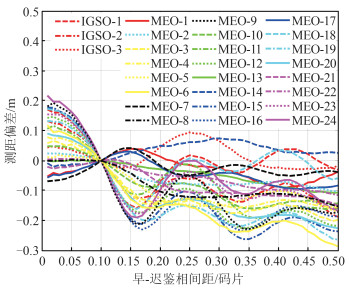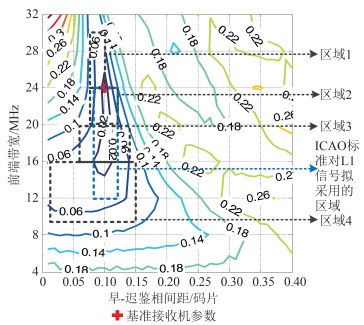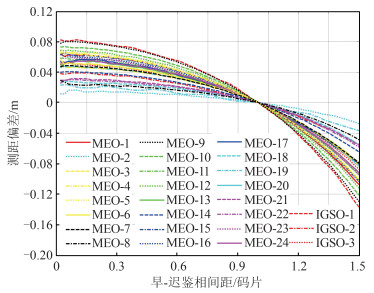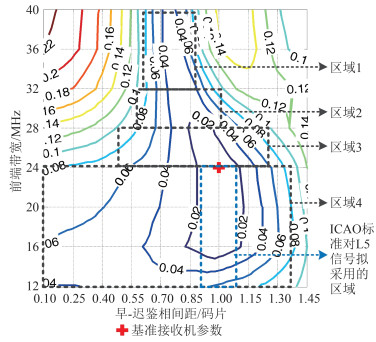Non-ideality Characteristic Analysis and Receiver Design Constraints Recommendation for BDS B1C and B2a Signals
-
摘要: 卫星导航信号的非理想性会导致不同接收机之间出现测距偏差,是影响卫星导航系统服务精度和完好性的重要因素。首先,针对北斗系统B1C、B2a新体制信号的非理想性进行分析,利用大口径天线采集了全部北斗三号在轨卫星播发的B1C、B2a信号(共27颗卫星),评估了不同接收带宽、码鉴相间距下测距偏差的大小与变化特点;然后,以双频多星座星基增强服务应用为例,分析了两个信号在相应接收机中的设计约束条件。研究结果发现,在接收机常用的参数范围内,B1C、B2a信号非理想性引入的测距偏差分别不超过0.68 m、0.44 m;在测距偏差小于0.1 m的性能约束下,B1C、B2a信号可用的约束条件参数范围优于国际民航标准草案中的相关要求。Abstract:Objectives Non-ideality of navigation satellite signals can cause ranging bias between different receivers, which is an important factor that may degrade the accuracy and integrity performance of global navigation satellite system. In civil aviation and other high integrity services, it is necessary to consider the non-ideality characteristics of the signal and define the design constraints of the user receiver, so as to reduce the impact of non-ideality and ensure service safety.Methods The B1C and B2a signals of BeiDou satellite navigation system (BDS) are planned to join the international civil aviation standard, so it is necessary to study their non-ideality characteristics and define the receiver design constraints. This paper analyzed the non-ideality characteristic of BDS B1C and B2a signals. In order to avoid the influence of noise and multipath, a large aperture antenna was used to collected all the in-orbit satellite broadcasting B1C and B2a signals (including 27 satellites) to obtain pure signal samples. Then, the software receiver was used to process the signal samples under various receiving parameters to obtain the ranging biases under different receiver front-end bandwidth and code discriminator space, and the ranging bias range and variation with the receiving parameters are evaluated. Furthermore, taking the application in dual frequency multi-constellation satellite based augmentation service as an example, the receiver design constraints of the two signals were analyzed.Results and Conclusions The experimental results show that the range biases introduced by the non-ideality of B1C and B2a signals are less than 0.68 m and 0.44 m, respectively, under the parameters range commonly used by receivers. Under the requirement of range bias less than 0.1 m, the applicable parameter range of receiver design constraints for B1C and B2a signals is better than the relevant requirements of the international civil aviation organization draft standard. There is sufficient margin to further consider other constraints.
-
Keywords:
- B1C signal /
- B2a signal /
- non-ideality /
- ranging bias /
- receiver design constraints
-
-
表 1 B1C信号接收机可用参数范围
Table 1 Applicable Receiver Parameters for B1C
区域名称 前端带宽/MHz 鉴相间距/码片 B1C信号区域1 24~30 0.08~0.1 B1C信号区域2 20~24 0.08~0.12 B1C信号区域3 16~20 0.06~0.13 B1C信号区域4 10~16 0.01~0.15 ICAO对GNSS系统L1信号拟采用的区域[17] 12~24 0.08~0.12 表 2 B2a信号接收机可用参数范围
Table 2 Applicable Receiver Parameters for B2a
区域名称 前端带宽/MHz 鉴相间距/码片 B2a信号区域1 32~40 0.6~0.8 B2a信号区域2 28~32 0.6~1.0 B2a信号区域3 24~28 0.5~1.2 B2a信号区域4 12~24 0.1~1.4 ICAO对GNSS系统L5信号拟采用的区域[17] 12~24 0.9~1.1 -
[1] Pagot J B, Thevenon P, Julien O, et al. Estimation of GNSS Signals' Nominal Distortions from Correlation and Chip Domain[C]//The 2015 International Technical Meeting of the Institute of Navigation, San Diego, California, USA, 2015.
[2] Phelts R E, Walter T, Enge P, et al. Signal Deformation Monitoring for Dual-Frequency WAAS[C]//The 2013 International Technical Meeting of the Institute of Navigation, San Diego, California, USA, 2013.
[3] Wong G, Phelts R E, Walter Tet al. Alternative Characterization of Analog Signal Deformation for GNSS-GPS Satellites[C]//The 2011 International Technical Meeting of the Institute of Navigation, San Diego, California, 2011.
[4] Wong G, Phelts R E, Walter T, et al. Characterization of Signal Deformations for GPS and WAAS Satellites[C]//The 2010 International Technical Meeting of the Institute of Navigation, San Diego, California, 2010.
[5] Soellner M, Kurzhals C, Kogler W, et al. One Year in Orbit: GIOVE-B E1 CBOC Signal Quality Assessment[J]. GPS World, 2009, 20(9): 28-38.
[6] Gunawardena S, Carroll M, Raquet J, et al. High-Fidelity Signal Deformation Analysis of Live Sky Galileo E1 Signals Using a Chip Shape Software GNSS Receiver[C]//ION GNSS+, Tampa, Florida, USA, 2015.
[7] Wanninger L, Beer S. BeiDou Satellite-Induced Code Pseudorange Variations: Diagnosis and Therapy[J]. GPS Solutions, 2015, 19(4): 639-648. doi: 10.1007/s10291-014-0423-3
[8] 楼益栋, 龚晓鹏, 辜声峰, 等. 北斗卫星伪距码偏差特性及其影响分析[J]. 武汉大学学报(信息科学版), 2017, 42(8): 1040-1046. doi: 10.13203/j.whugis20150107 Lou Yidong, Gong Xiaopeng, Gu Shengfeng, et al. The Characteristic and Effect of Code Bias Variations of BeiDou[J]. Geomatics and Information Science of Wuhan University, 2017, 42(8): 1040-1046. doi: 10.13203/j.whugis20150107
[9] 许扬胤, 杨元喜, 何海波, 等. 北斗全球卫星导航系统试验卫星测距信号质量分析[J]. 武汉大学学报(信息科学版), 2018, 43(8): 1214-1221. doi: 10.13203/j.whugis20160219 Xu Yangyin, Yang Yuanxi, He Haibo, et al. Quality Analysis of the Range Measurement Signals of Test Satellites in BeiDou Global System[J]. Geomatics and Information Science of Wuhan University, 2018, 43(8): 1214-1221. doi: 10.13203/j.whugis20160219
[10] 何义磊. 北斗三号最简系统卫星信号质量分析[J]. 武汉大学学报(信息科学版), 2020, 45(3): 394-402. doi: 10.13203/j.whugis20180379 He Yilei. Quality Analysis of Satellite Signal for BDS-3 Simplest System[J]. Geomatics and Information Science of Wuhan University, 2020, 45(3): 394-402. doi: 10.13203/j.whugis20180379
[11] Edgar C, Czopek F, Barker B. A Co-operative Anomaly Resolution on PRN-19[C]//ION GPS, Nashville, Tennessee, 1999.
[12] Enge P, Phelts E, Mitelman A. Detecting Anomalous Signals from GPS Satellites[C]//ICAO, Toulouse, France, 1999.
[13] Phelts R E, Shallberg K, Walter T, et al. WAAS Signal Deformation Monitor Performance: Beyond the ICAO Threat Model[C]//The ION 2017 Pacific PNT Meeting, Honolulu, Hawaii, USA, 2017.
[14] 张铮文, 寇艳红, 刘建胜. 发射信号不完善性对卫星导航系统内及系统间干扰的影响分析[J]. 武汉大学学报(信息科学版), 2011, 36(4): 471-475. http://ch.whu.edu.cn/article/id/526 Zhang Zhengwen, Kou Yanhong, Liu Jiansheng. Impact Analysis of GNSS Signal Imperfections on Intersystem and Intrasystem Interference[J]. Geomatics and Information Science of Wuhan University, 2011, 36(4): 471-475. http://ch.whu.edu.cn/article/id/526
[15] International Civil Aviation Organization. ISBN 978-92-9258-504-4. ICAO International Standards and Recommended Practices. Annex 10 to the Convention on International Civil Aviation. Volume I Radio Navigation Aids Seventh Edition[S]. Canada: International Civil Aviation Organization, 2018.
[16] Wong G. Impact of Nominal Signal Deformations on Satellite Navigation Systems[D]. California: Stanford University, 2014.
[17] Pagot J B. Modelling and Monitoring of New GNSS Signal Distortions in the Context of Civil Aviation[D]. Toulouse, France: Signal and Image Processing, Institute National Polytechnique de Toulouse (INPT), 2016.
[18] Lu M Q, Li W Y, Yao Z, et al. Overview of BDS Ⅲ New Signals[J]. Navigation, 2019, 66(1): 19-35.
[19] 中国卫星导航系统管理办公室. BDS-SIS-ICD B1C-1.0北斗卫星导航系统空间信号接口控制文件公开服务信号B1C (1.0版)[S]. 北京: 中国卫星导航系统管理办公室, 2017. China Satellite Navigation Office. BDS-SIS-ICD B1C-1.0 BeiDou Navigation Satellite System Signal in Space Interface Control Document Open Service Signal B1C (Version 1.0)[S]. Beijing: China Satellite Navigation Office, 2017.
[20] Yao Z, Lu M, Feng Z M. Quadrature Multiplexed BOC Modulation for Interoperable GNSS Signals[J]. Electronics Letters, 2010, 46(17): 1234.
[21] Yao Z, Lu M. Optimized Modulation for Compass B1C Signal with Multiple Processing Modes[C]//The 24th International Meeting of the Satellite Division, Portland, Oregon, USA, 2011.
[22] 中国卫星导航系统管理办公室. BDS-SIS-ICD B2a-1.0北斗卫星导航系统空间信号接口控制文件公开服务信号B2a (1.0版)[S]. 北京: 中国卫星导航系统管理办公室, 2017. China Satellite Navigation Office. BDS-SIS-ICD B2a-1.0 BeiDou Navigation Satellite System Signal in Space Interface Control Document Open Service Signal B2a (Version 1.0)[S]. Beijing: China Satellite Navigation Office, 2017.
[23] Yao Z, Lu M. Dual-frequency Constant Envelope Multiplex with Non-equal Power Allocation for GNSS[J]. Electronics Letters, 2012, 48(25): 1624-1625.
[24] Lu M Q, Yao Z. Constant Envelope Combination for Components on Different Carrier Frequencies with Unequal Power Allocation[C]//ION ITM, San Diego, CA, USA, 2013.
[25] Gunawardena S, Graas F. Analysis of GPS Pseudorange Natural Biases Using a Software Receiver[C]//ION GNSS, Nashville, Tennessee, USA, 2012.
[26] Gunawardena S, Graas F. High Fidelity Chip Shape Analysis of GNSS Signals Using a Wideband Software Receiver[C]//ION GNSS, Nashville, Tennessee, USA, 2012.






 下载:
下载:





